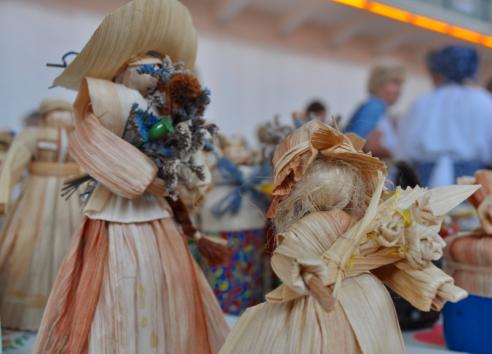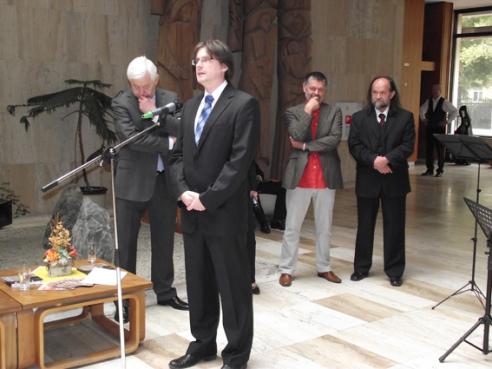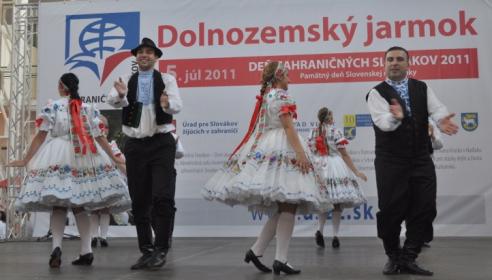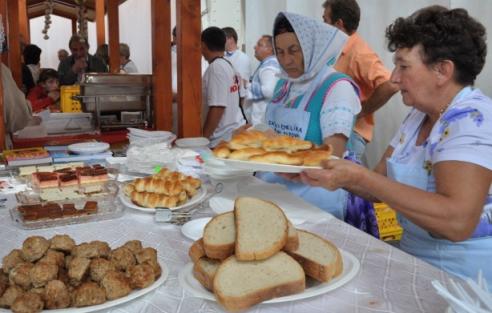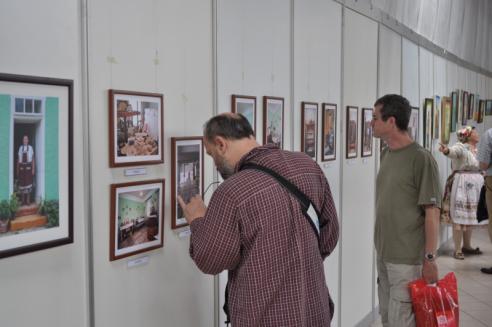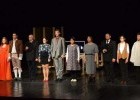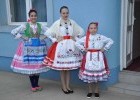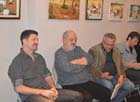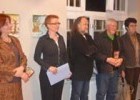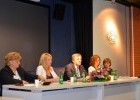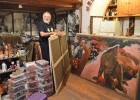Slovaks living abroad day 2011
There are many people who have Slovak nationality and nowadays live in foreign countries. With a goal to develop and reinforce relations between the mother country Slovakia and the Slovaks living abroad, the National council of Slovak republic has decided to dedicate one day which would be eventful. The date which has been chosen is July the 5th, when in the same time there is a feast and state day of the st. Cyril an Methodius. This festival is celebrated all over Slovakia and it is time when the culuture of Slovaks living abroad is presented in the best way.
Photo: Daniela Klobušicki |
This year citizens of Slovakia and everyone who was interested in Slovak culture could visit many cultural undertakings. This years eventful day was realized under the auspices of the Slovak Government Prime Minister Iveta Radičová.
The first day of celebration was the 4th July. On this day there has been an opening of the exhibiton of the academic painter from Vojvodina Pavel Čáni, which was held in the foyer of the Slovak republic Government Department. The exhibition has been opened with a speech of the Deputy Prime Minister of Slovakia Rudolf Chmel, President of the Office for Slovaks living abroad Milan Vetrák and the art critic from Vojvodina Vladimír Valentík. The opening was dulcifyied with the music quartet of Ján Brtka, Michal Harin, Filip Štrauch and Juraj Tomka.
Photo: Andrej Meleg |
On the next day by the foundational stone which is a memorable for the Slovak emigration in the Sad of Janko Kráľ, there has been a cultural undertaking with few oficial intercedations. One of the most meaningful event was also the 4th annual of the Slovak meeting from the Low Land called At the fair.
Photo: Daniela Klobušicki |
The meeting of the Slovaks from the Low Land (Hungary, Romania, Serbia) called At the fair 2011 was on July the 5th this time it was held in the old market hall which is on the square SNP in Bratislava, Slovakia. This was the first time that the Low Land fair was held in Slovakia. On this fair many could see the richness of the folk garbs, many manufacturers, old handicrafts and naive painters. Beside all mentioned everybody could taste the tradittional Slovak gastronomic specialities from the Low Land.
Photo: Daniela Klobušicki |
When it comes to abonents from Serbia, At the fair there were representatives from the county of Báčka, Banát and Sriem. To be more precise from places where Slovaks live like Báčsky Petrovec, Kysáč, Aradáč, Stará Pazova, Hložany, Kovačica, Biele Blato, Selenča, Pivnica, Vojlovica a Nový Sad. The visitors had the opportunity to see priadky (traditional custom), pierkarky (feather ladies), metliarov (making brooms), violin makers, vine makers, etc. On the other hand there were many specs which were like if they were made in grandmothers kitchen from Vojvodina. The citizens of Bratislava were offered with petrovskie klbásy (famous picante saussage from a town called Petrovec), kysácka sárma (forcemeat with rice in a sour cabage leaf), pirohe (paste with homemade jam and poppy seed), rezance (homemade noodles) and many other homemade specs which are specific for Vojvodina Slovaks.
Photo: Daniela Klobušicki |
While some werre cooking others were singing, dancing and acting on the scene to entertain the visitors. For a good mood the famous harmonica players were playing folk music, also the orchestra called Rosička and a scenic speech was presented by SKOS Detvan from a Slovak town in Serbia called Vojlovica and KUS Jednota from Hložany. Witty scenes from the peasant life of Vojvodina Slovaks were played by Zuzana Tarnóciová and Ondrej Brna.
Within the Slovaks living abroad day there has been also an exhibiton of photographies which was called Women on the village. This exhibiton came to life thanks to cooperation between profesors and students from the Art Academy form Novi Sad. Theese photographies have traveled over ten towns in Serbia where they were shown. The goal of this exhibition is to show the riches of the work that women on villages do.
Photo: Daniela Klobušicki |
Also under the Čabian organization of the Slovaks from Hungary and the Demokratic association of Slovaks and Czech in Romania, there were presented At the fair also the folk dancing group called Salašan, the choir called Čabianska ružička, zhiterists, and many other adepts of the folk crafts and also slovak meals and food in general which are chracteristic for Slovaks from Hungary and Romania.
The central organizator of the 4th annual undertaking called At the fair was the Office for Slovaks living abroad. In this project the partner from Serbia was the Slovak National Council of Slovak National minority. The Vojvodina Slovaks cultural institute was the coorganizator of the undertaking At the fair 2011 and it provided abonents from Vojvodina who have not only presented the Slovak culture which is nurtured for more than 250 years in Vojvodina, but also entertained the visitors.
The director of the Cultural Institute of Vojvodina’s Slovaks Milina Sklabinská through the interview expressed her opinion about the implementation of this undertaking At the fair 2011 as following:
This year’s Fair is the fourth of which the Institute is the co-organizer are you satisfied with its implementation?
 |
When you consider the fact that this was a mass event, we put a great effort for its preparation due to which we had high expectations. I can say that the first impression that I have from the event is a large number of visitors and their special interest in traditional culture of Slovaks from the Low Land. Because there came three times as many people as we were expecting and that is what is important. I believe that the central organizer, the Office for Slovaks living abroad, will consider about organizing similar events in Bratislava and in Slovakia at all, and still shape a lot of similar actions, which will enable the local Slovaks to affirm their products in the broadest sense.
What was the purpose of this project?
The original idea of presenting Low Land culture in gastronomy, traditional crafts and expressions of spiritual culture have proposed four years ago by Anna Ištvánová from Hungary and the first Low Land fair has been held in Hungary later in Serbia and Romania. The intention was to present Slovak culture from the Low Land by teams Hungary – Slovaks from Hungary in Serbia – Slovaks from Serbia in Romania – Slovaks from Romania and of course in Slovakia - Slovaks from Slovakia. This was something new when comparing our fair to other similar ethnic gastronomic events - to introduce our culture to others. Our Institute was co-organizer of the event for three years now and what I see as the strength and potential of events such as this one are the common parts as much as the three communities as well as their differences, naturally developed culture for nearly three centuries. It is these points of contact but also the particularities and specificities of Slovak communities in Hungary, Romania and Serbia which give perspective to this event.
Did the event at the fair 2011 offer visitors some news?
The biggest news was probably that we presented the Slovak Low Land culture to audience in the capital of Slovakia. Unlike past experiences, when we did the action in environments that we know, we tried a fair in an urban environment. Interest Bratislavian’s showed really pleased me, it was definitely a good decision. At this time when we are affected by globalization process and unification, it is very desirable to remember the former ways of life and also learn much from them. For example, foods that offer the traditional mostly made out of few ingredients which once were available and they are tasty, healthy and cheap meals. Parallels can be found in traditional crafts and not to mention the cultivation of traditional forms of culture that are the basis of its national feeling.
Are you satisfied with the visitation of the fair?
With the visitation I am extremely satisfied. I regret that we did not have enough of the famous Petrovská klbása (sausage), kysáčskej sármy, and many other savory and sweet dishes and wines which were not enough for all. But what did not lack was the good mood and numerous meetings which made this day unforgettable.
Are there plans to implement actions of this kind in the future?
Event At the fair, I believe will continue because it was realized very well so far. However, we will advocate so that the similar events would be held in Bratislava in the future, because our Slovaks showed only a pinch of what we have. It is well to create the conditions for such logistical support to all our societies, associations and individuals because I know they have much to offer. At the same time, this self-realization may make them less dependent on grants to provide greater autonomy and development. In other words, the unfailing support, which ultimately belongs to our goals.







